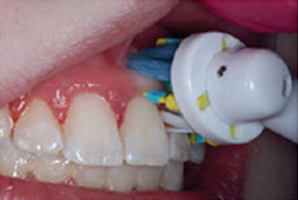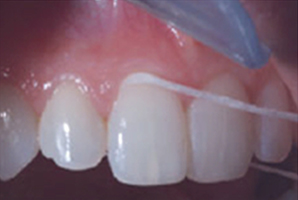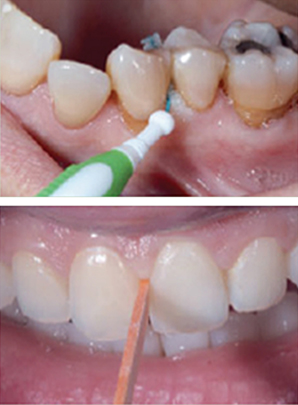Peri-implantitis: All You Want (or not) To Know
Course Number: 680
Primary Prevention
An integral part of dental implant related treatment plan should include meticulous home care and strict follow-up and maintenance protocols. This should be instilled in the patients prior to the implant placement to ensure that long term health conditions can be maintained around the implant. Prior to implant placement, oral hygiene instruction should be a big portion of the initial implant consultation. This includes demonstrating proper brushing and interdental cleaning techniques to the patient and ensuring they are understanding the oral hygiene instructions at follow up appointments. Patients should have to prove to the dental professional that they will be able to maintain the appropriate homecare protocols prior to implant placement. In regards to professional maintenance, patients are required to understand the increased recall regime that is required to maintain the dental implants. The recall regimen for patients is recommended to be approximately three to six months, however, patients who present with risk factors should have a significantly shorter recall. Having patients have frequent recalls increases the ability of the dental professional to diagnose complications at the earliest state possible and was shown to increase success rates of dental implants.11,12
Appropriate tools need to be recommended and practiced together with the patient in a proper way to remove all plaque around the teeth and implants in the oral cavity. This should include proper brushing and inter-proximal cleaning as well.4,5,11,12 According to the American College of Prosthodontists’ Clinical Practice Guidelines for recall and maintenance of patients with tooth-borne and implant-borne restorations, patients should be using an electric toothbrush to effectively remove biofilm as one of the specific oral hygiene aids for at-home maintenance.13
Evidence showed that oscillating-rotating (O-R) powered toothbrushes demonstrate more plaque removal and reduce the number of bleeding sites better than other powered toothbrushes.14 A meta-analyses showing 50% greater reduction in bleeding sites compared to manual brushes and 28% greater reduction in bleeding sites versus sonic (side-to-side motion) brushes.15 Subjects with localized or generalized gingivitis had 7.4 times better odds of transitioning from gingivitis to a healthy state after using an electric O-R brush versus a manual brush. Moreover, electric toothbrush users showed significantly lower progression for mean probing depth (22.0%), clinical attachment loss (21.0%), tooth loss (20%), and decayed/missing/filled surfaces (17.7%) compared to manual toothbrush users. When evaluated on dental implant patients, powered toothbrushes were found to be effective, safe and comfortable for patients rehabilitated by means of oral implant-supported prostheses. At the end of a 12-month study of 80 peri-implant patients replacing their manual brush with an oscillation-rotation brush, the mean overall pocket depth decreased by 0.3mm, mean recession decreased by 0.1mm, no gingival or mucosal ulcerations/desquamations were observed, and high scores were given to convenience and comfort of the powered toothbrush with 95% indicating they would continue to use the powered brush. Therefore, it might be reasonable to recommend on oscillating-rotating (OR) powered toothbrushes for long-term dental implant maintenance and home care.
In many cases, the traditional inter-proximal cleaning methods such as string flossing are not user friendly for patients and do not provide the proper inter-proximal plaque removal. Thus, other inter-proximal cleaning aids should be introduced.16
Table 1. Oral Hygiene Recommended Devices and the Suggested Techniques.
| Devices | Instructions | Notes and Examples |
|---|---|---|
| Oscillating Electric Toothbrush | Place or park the brush head around the buccal surface of each tooth, leave it for 4 seconds, and move it to another tooth. Place the lower half of the brush head on the gingiva and the upper half of the cervical third of the tooth. When the buccal surfaces are completed, repeat the same process for the lingual surface of each tooth in the same manner. Lastly, place or park the brush head on the biting/occlusal surface of each tooth, apply apical pressure, leave the brush head for 4 seconds, move to another tooth, and repeat the same technique until completion of all occlusal surfaces. | Perform twice a day. Three times daily for severe periodontal patients or high caries risk patients. |
| Floss | Once passing the interproximal contact, hug/wrap around the distal side of the anterior tooth, slide the floss apically until the floss disappears 2-3mm subgingivally. Move the floss coronally and apically 2-3 times. Repeat the same on the mesial side of the posterior tooth. When completed, slide the floss out by pulling it buccally. Repeat the same technique for all interproximal contacts. | Perform twice a day. Suitable for patients with healthy periodontium or low caries risk as well as for patients with periodontitis, who have very high dexterity skills and motivation. |
| Rubber Tip Stimulator | Place the pointy tip interproximally from the buccal side. Press lingually until the tip is fully engaging. Then, draw 5 circles especially with the apical pressure until the gingiva blanches. Repeat the same technique for all interproximal surfaces. Once completed, repeat the same from the lingual side. | For patients with healthy periodontium or gingivitis, perform once a day. Excessive use may induce interproximal recession. For patients with periodontitis, perform 2-3 times a day. |
| Interdental Brush/ Triangular-Shaped Wooden Toothpick | Place the brush/toothpick between the two teeth from the buccal aspect. Gently push and pull five times from the buccal to the lingual aspect. Ensure the brush/toothpick completely passes through the buccal embrasure to the lingual embrasure. For the toothpick, the apex or the tip of the triangle should be pointing occlusally while the base of the triangle should be in contact with interproximal papilla. | Perform twice a day. Suitable for patients with periodontitis, who have difficulty with effectives effective flossing. Help patients identify the size that fits their embrasures. |
Adapted from Kwon TH, Salem DM, Levin L. The role of home care therapy in periodontal disease treatment and management. Quintessence Int. 2023 Apr 11;54(4):288-295.
Figure 7. Inter-proximal plaque removal tools. Interdental brush (left) and triangular wooden toothpick (right)
Figure 7. Inter-proximal plaque removal tools. Interdental brush (left) and triangular wooden toothpick (right)



